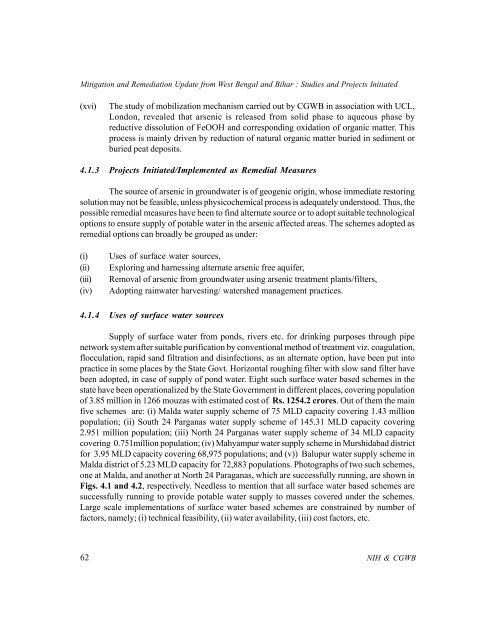Mitigation and Remedy of Groundwater Arsenic Menace in India
Mitigation and Remedy of Groundwater Arsenic Menace in India
Mitigation and Remedy of Groundwater Arsenic Menace in India
Create successful ePaper yourself
Turn your PDF publications into a flip-book with our unique Google optimized e-Paper software.
<strong>Mitigation</strong> <strong>and</strong> Remediation Update from West Bengal <strong>and</strong> Bihar : Studies <strong>and</strong> Projects Initiated(xvi)The study <strong>of</strong> mobilization mechanism carried out by CGWB <strong>in</strong> association with UCL,London, revealed that arsenic is released from solid phase to aqueous phase byreductive dissolution <strong>of</strong> FeOOH <strong>and</strong> correspond<strong>in</strong>g oxidation <strong>of</strong> organic matter. Thisprocess is ma<strong>in</strong>ly driven by reduction <strong>of</strong> natural organic matter buried <strong>in</strong> sediment orburied peat deposits.4.1.3 Projects Initiated/Implemented as Remedial MeasuresThe source <strong>of</strong> arsenic <strong>in</strong> groundwater is <strong>of</strong> geogenic orig<strong>in</strong>, whose immediate restor<strong>in</strong>gsolution may not be feasible, unless physicochemical process is adequately understood. Thus, thepossible remedial measures have been to f<strong>in</strong>d alternate source or to adopt suitable technologicaloptions to ensure supply <strong>of</strong> potable water <strong>in</strong> the arsenic affected areas. The schemes adopted asremedial options can broadly be grouped as under:(i)(ii)(iii)(iv)Uses <strong>of</strong> surface water sources,Explor<strong>in</strong>g <strong>and</strong> harness<strong>in</strong>g alternate arsenic free aquifer,Removal <strong>of</strong> arsenic from groundwater us<strong>in</strong>g arsenic treatment plants/filters,Adopt<strong>in</strong>g ra<strong>in</strong>water harvest<strong>in</strong>g/ watershed management practices.4.1.4 Uses <strong>of</strong> surface water sourcesSupply <strong>of</strong> surface water from ponds, rivers etc. for dr<strong>in</strong>k<strong>in</strong>g purposes through pipenetwork system after suitable purification by conventional method <strong>of</strong> treatment viz. coagulation,flocculation, rapid s<strong>and</strong> filtration <strong>and</strong> dis<strong>in</strong>fections, as an alternate option, have been put <strong>in</strong>topractice <strong>in</strong> some places by the State Govt. Horizontal rough<strong>in</strong>g filter with slow s<strong>and</strong> filter havebeen adopted, <strong>in</strong> case <strong>of</strong> supply <strong>of</strong> pond water. Eight such surface water based schemes <strong>in</strong> thestate have been operationalized by the State Government <strong>in</strong> different places, cover<strong>in</strong>g population<strong>of</strong> 3.85 million <strong>in</strong> 1266 mouzas with estimated cost <strong>of</strong> Rs. 1254.2 crores. Out <strong>of</strong> them the ma<strong>in</strong>five schemes are: (i) Malda water supply scheme <strong>of</strong> 75 MLD capacity cover<strong>in</strong>g 1.43 millionpopulation; (ii) South 24 Parganas water supply scheme <strong>of</strong> 145.31 MLD capacity cover<strong>in</strong>g2.951 million population; (iii) North 24 Parganas water supply scheme <strong>of</strong> 34 MLD capacitycover<strong>in</strong>g 0.751million population; (iv) Mahyampur water supply scheme <strong>in</strong> Murshidabad districtfor 3.95 MLD capacity cover<strong>in</strong>g 68,975 populations; <strong>and</strong> (v)) Balupur water supply scheme <strong>in</strong>Malda district <strong>of</strong> 5.23 MLD capacity for 72,883 populations. Photographs <strong>of</strong> two such schemes,one at Malda, <strong>and</strong> another at North 24 Paraganas, which are successfully runn<strong>in</strong>g, are shown <strong>in</strong>Figs. 4.1 <strong>and</strong> 4.2, respectively. Needless to mention that all surface water based schemes aresuccessfully runn<strong>in</strong>g to provide potable water supply to masses covered under the schemes.Large scale implementations <strong>of</strong> surface water based schemes are constra<strong>in</strong>ed by number <strong>of</strong>factors, namely; (i) technical feasibility, (ii) water availability, (iii) cost factors, etc.62NIH & CGWB




